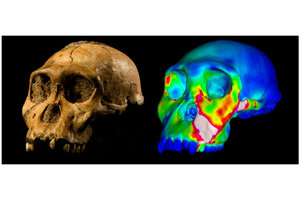Chew on this: What a 2-million-year-old bite could tell us about our evolution
A recent study on the jaw structure and bite of a 2 million-year-old species could help place humans more precisely on the evolutionary tree, and show if the species is a possible candidate for one of our earliest ancestors.

The fossilised skull of Australopithecus sediba specimen MH1 and a finite element model of its cranium depicting strains experienced during a simulated bite on its premolars. “Warm” colors indicate regions of high strain, while “cool” colors indicate regions of low strain.
Image of MH1 by Brett Eloff provided courtesy of Lee Berger and the University of the Witwatersrand
New research on the jaw of a possible evolutionary ancestor shows that the species may have shared some of the same food preferences as modern-day humans.
A study on the bite of Australopithecus sediba published in Nature Communications Monday suggests that the small, apelike species may have had comparable diets to members of Homo sapiens – modern humans – as well as similar limitations when it came to tough-to-chew foods.
Australopiths emerged in Africa between 3.5 million and 4 million years ago, and the appearance of A. sediba is dated around 2 million years ago. First discovered in 2008 in South Africa, A. sediba had surprisingly humanlike hands and may have combined walking on two legs with climbing trees. And the species face seems to have also been very different from other members of its genus.
“Most australopiths had amazing adaptations in their jaws, teeth and faces that allowed them to process foods that were difficult to chew or crack open. Among other things, they were able to efficiently bite down on foods with very high forces,” study co-author David Strait, an anthropology professor at Washington University in St. Louis, said in a release from the University of the Witwatersrand.
Research released in 2012 posited that, like its fellow australopiths, A. sediba may have lived off of very hard foods including bark, but the new evidence suggests that A. sediba could have been limited in the jaw adaptations that distinguished other australopiths.
Scientists are interested in this new development, as A. sediba is considered to be one of the closest possible ancestors of H. sapiens, especially compared with other australopiths. Both Homo and Australopithecus are members of the tightly related Hominini tribe, which is comprised of those two genera as well as the Pan genus, which today comprises chimpanzees and bonobos.
Insight into one of the species closest to humans on our evolutionary tree could lead to new evidence over how that tree developed, and what taxa Homo and H. sapiens are most closely linked to.
“Humans also have this limitation on biting forcefully and we suspect that early Homo had it as well, yet the other australopiths that we have examined are not nearly as limited in this regard,” said Justin Ledogar, a study co-author and researcher at the University of New England in Australia, in a press release. “This means that whereas some australopith populations were evolving adaptations to maximize their ability to bite powerfully, others (including A. sediba) were evolving in the opposite direction.
“Some of these ultimately gave rise to Homo,” Strait said. “Thus, a key to understanding the origin of our genus is to realize that ecological factors must have disrupted the feeding behaviors and diets of australopiths. Diet is likely to have played a key role in the origin of Homo.”
The study set out to examine what made A. sediba’s facial and dental structure, and therefore diet, “unlike other australopiths.” The analysis was completed using a computer model of an A. sediba skull initially recovered in 2008, using it to map strain and stresses during various force simulations.
The conclusion reached from the virtual A. sediba construction was that “foods most important to its survival may not have been mechanically challenging to process in the oral cavity,” and that “even though A. sediba may have been able to eat some hard foods, it is very unlikely to have been adapted to eat hard foods,” according to Strait.
“Our study provides a really nice demonstration of the difference between reconstructing the behaviors of extinct animals and understanding their adaptations,” he said.
While a definite distinction of A. sediba as the Homo genus’ australopith ancestor, the similarities found between its bite processes and bone structure could point to it being that ancestor or something very close to it.

